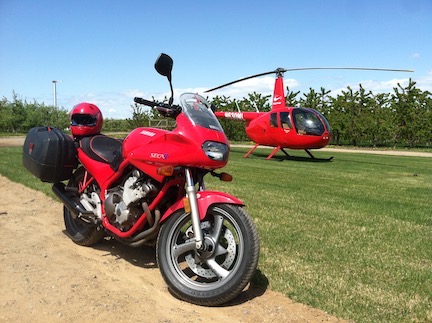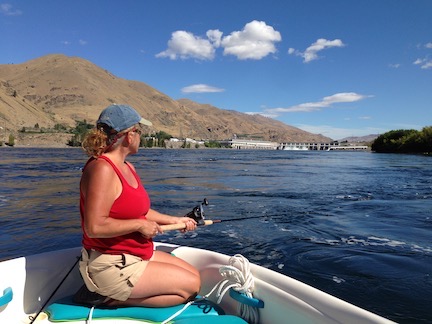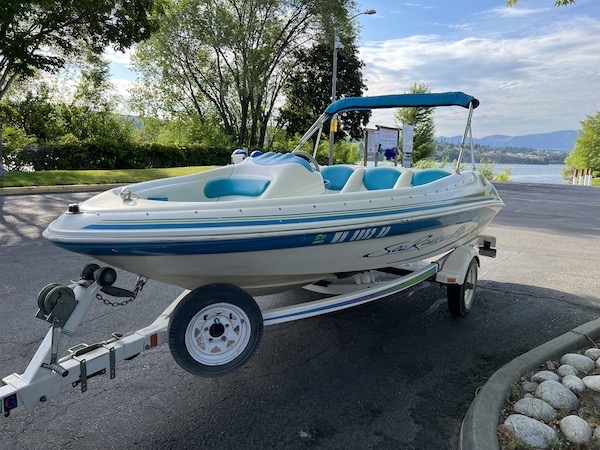Adventures come in all shapes and sizes. I really am on one now.
If you’re not aware that I’m on a year+ long, mostly solo journey in a 2019 Ranger Tug R-29 CB along America’s Great Loop, you might not know what I’m talking about in this post. This 6000+ mile trip to circumnavigate the eastern US by boat has taken me the better part of fourteen months (so far) with stops in 13 states. Because I took last summer off and then backtracked from Annapolis to Key West, I’m only about halfway finished. You can read more about it in the blog where I’m supposed to be telling related stories, My Great Loop Adventure.
Lately, as I meet people along my Great Loop travels, I’ve been told repeatedly that they admire me or what I’m doing or both. They seem to think that traveling mostly solo in a well-equipped, small but comfortable trawler along well-established waterways in the United States is some sort of special feat or adventure.
(I suspect their comments are rooted in old stereotypes about women and how we’re considered adventurous for doing any travel alone. After all, would they be making the same comments to a man in my place? And they definitely don’t say anything like this to me when I’m traveling with a companion. But I digress.)
That got me thinking a little bit differently about the trip. I do have to admit that it is quite an adventure.
What Makes This Trip an Adventure
There are lots of things that make this trip an adventure.
First of all, I’m piloting a boat that was brand new to me when I started back in October 2022. Not only did I need to learn about all of its systems and how to keep them in working order, but I had to build skills so I could safely dock, anchor, and use locks — sometimes with challenging currents, winds, or both. Although I had a companion on board for the first 44 days of the trip, I went solo for months after that so I needed to be able to do everything by myself. I made some mistakes — or should say I had enhanced learning experiences? — along the way, although (fortunately) none were catastrophic. Over time, I got a real feel for how the boat would move in most situations and just how powerful (or wimpy) my bow and stern thrusters could be when I needed them.
(I love the look on the faces of dockhands when I pull into a slip so slowly and smoothly that I can hand a line out my window to them on the dock and then get the boat to a stop before they even fasten that line. While it’s true that not every docking is perfect like that, more and more of them are. If my arms were longer, I’d be patting myself on the back every time.)
Then there’s the sheer length of the trip. The route I’m on is more than 6,000 nautical miles — that’s 6,900 statute miles for average Americans and about 11,000 kilometers for the rest of the world — much of which is on waterways I’ve never been on: Lake Michigan, the Inland Waterways, the Gulf Intracoastal Waterway, the Gulf of Mexico, the Okeechobee Canal and its lake, and most of the Atlantic Intracoastal Waterway. Later, I’ll do the NY Canal System and part of the Erie Canal to visit Lake Champlain and eventually the Trent-Severn Waterway in Canada. My only preparation for the Great Loop trip was a total of 10 weeks traveling with two other captains in their boats — covering a total of about 1500 nautical miles of the route — a bunch of reading, and a handful of webinars which were mostly narrated PowerPoint presentations, few of which had much useful information.
Although the route is pretty much well established, it does have variations and side trips are possible. So there’s no single set of directions I could follow — and I probably wouldn’t want to follow someone else’s directions anyway. I had to learn how to consult nautical charts, facilities information, and reliable weather information to plan each day’s journey. In all honesty, I had a lot of experience doing that from the many very long cross-country helicopter trips I did over a 20+ year period starting way back in 2000. But although planning was similar for these trips, it was just different enough to be a challenge. Instead of just worrying about where to get fuel or spend the night along the way, I now have to worry about fuel, water, pumpout, groceries, maintenance, and where I can tie up or anchor out, sometimes to wait out a storm. I’m not spending a day or two making a long trip; I’m now spending months on a trip.
The Captain’s course I took in April 2023 fell quite short of the kind of real-life information and experience a person needs to do a trip like this. It seemed more concerned with knowing lights and day signals on other boats than actual boat operation. For a week, I sat in a classroom to fulfill US Coast Guard training requirements and although I passed all four tests, I seriously doubt I’ll ever use more than half the information presented there — and most of that is either common sense or stuff I already knew from a lifetime of casual boat operations. Still, combined with my boating experience, CPR/first aid training, and medical exam, I became a certificated OUPV boat Captain in October 2023, supposedly qualified to be paid to teach skills to other boaters, move other people’s boats, and take up to six passengers on cruises.
Dealing with the Unexpected
But I think the thing that really makes a trip like this an adventure is when something unexpected happens that makes me change my plans radically. Such a thing happened on Friday.
I’m early on my northward travels — early when compared to the other folks traveling along the Great Loop. Most of them tend to linger in Florida as long as they can, soaking up the sun before rushing through the “boring” parts of Georgia and the Carolinas. I’m ahead of the pack because I have a deadline: I need to be at Colton’s Point just off the Potomac River by around April 4. That’s where my boat will be pulled out of the water to get its bottom cleaned, inspected, and possibly painted while I head west to see the solar eclipse and then spend a few weeks at home prepping my house for the summer. The eclipse takes all flexibility out of my travel plans. So I left Florida early, lingered in the places I liked, and hurried through the places I’d already seen and did not want to visit again. (Remember, I started in Annapolis, MD after taking the summer off for my last season of work and I headed south for the winter — all the way down to Key West. I’m now northbound again with a whole new crop of Loopers.)
That’s how I found myself getting ready to enter and cross several large bodies of water on the Atlantic ICW in North Carolina: the Neuse River, The Pamlico River, and the Albemarle Sound.
Securing ALL loose items before getting into rough water can prevent a mess like this.
The Neuse River really kicked my ass last year. With an outgoing tide and incoming wind, the 1-2 foot forecasted waves manifested themselves as 2-5 foot waves. I couldn’t speed through them because they were right on my bow and the crashing down after each peak was unnerving, to say the least. So I had to do the 12 miles or so from Oriental at about 5 knots. Each of my dogs puked twice and I got close once. When it came time to make the 90° turn into the Bay River, I couldn’t do it — doing so would have put those big waves on my beam and there was a real risk of filling my aft cockpit with water. So I had to “tack” my way into the turn like a sailboat riding against the wind, zig-zagging until I was far enough into the river to shelter me from those big waves. The whole ordeal took more than 3 hours and I still had to get across the Pamlico River and up the Pungo River to Belhaven. At the marina, I spent an hour picking up everything that had been tossed on the floor of my boat’s cabin and cleaning up dog puke.
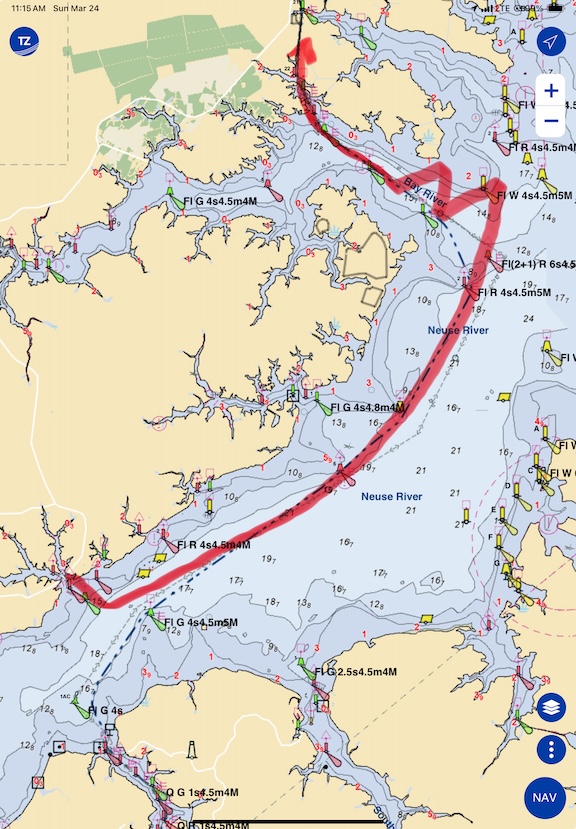
Here’s a general look at the route I had to take to get down the Neuse River and then into the Bay River.
(I need to mention here that it’s always a good idea to have a boat that can handle rougher conditions than you can. My boat is literally sea worthy — it is built to handle ocean conditions. It had no problem dealing with the Neuse River.)
I picked a better day this year. It was rough with 1-3 foot waves, but the wind and current were behind me. I was able to keep my speed up and get through it all, without making a zigzag turn, in a little over an hour. The Pamlico and Pungo were both kind to me, too.
From Belhaven, I have to go into the Alligator River-Pungo River Canal. I can then stop at the Alligator River Marina at the mouth of that river about 40 nautical miles away from Belhaven or continue on across the Albemarle Sound, which is the biggest body of water before I get to Chesapeake Bay, north of Norfolk.
There are two ways to get from the mouth of Alligator River across Albemarle Sound to the Norfolk area of Virginia:
- The Virginia Cut is favored by larger, faster boats, as well as boats with deep drafts and/or tall masts. It’s a combination of natural waterways and canal cuts that go through Coinjock and Great Bridge. There’s even a lock at Great Bridge. That’s the way I came south in October, mostly because I wanted to try the prime rib at Coinjock, which everyone raves about. (I was not impressed.)
-
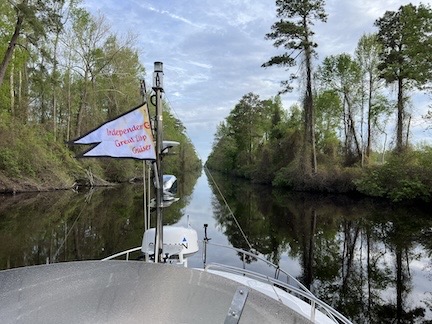
The Great Dismal Swamp is great but not really dismal.The Great Dismal Swamp Canal is favored by slow cruisers, including most Loopers, I think. It’s a slow route that runs from Elizabeth City through the Great Dismal Swamp’s canal and two locks. There’s a 5 mph speed limit in the main canal, which is also very narrow and shallow at some points. That’s how I came north last April and I absolutely loved it.
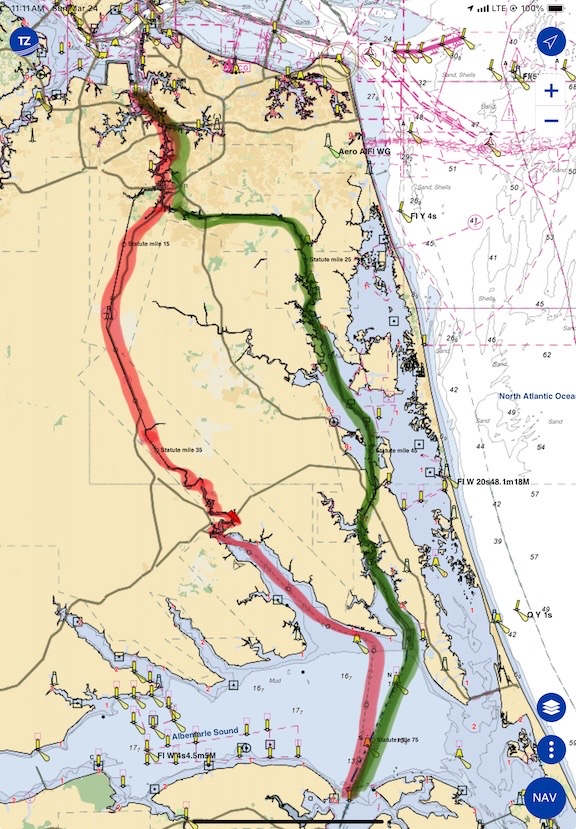
Here are the two different routes from Alligator River to Norfolk: green is the Virginia Cut and red is the Great Dismal Swamp.
I had already decided to go through the swamp. I loved it so much last year, I couldn’t wait to do it again. In fact, it was going to be the highlight of my trip north. With weather moving in on Saturday and apparently no other Loopers nearby to compete for the limited dock space at the rest area in the middle of the swamp, I felt pretty confident I could get a second day in its peace and quiet, hanging out on my boat until the rain passed through and I could continue north on Sunday.
So I left Belhaven on Thursday and did the 70+ nautical mile trip up the Pungo River, through the Alligator-Pungo Canal, down the Alligator River, and across Albemarle Sound. The two rivers were choppy, the canal was nearly dead calm, and the sound was a bit rough, with 1 to 3 foot waves. It wasn’t much worse than the Neuse had been the day before, but I could not go directly across the Sound to the Pasquotank River because I’d have to put those waves on my beam. So I kept a more northerly direction, putting the waves about 10° to 20° off my starboard bow. When I got about halfway across, the swells eased up — they were wind generated from the north, after all and I was getting closer to land. At that point, I was able to make my turn, go up the River, and stop at one of Elizabeth City’s three free docks for the night.
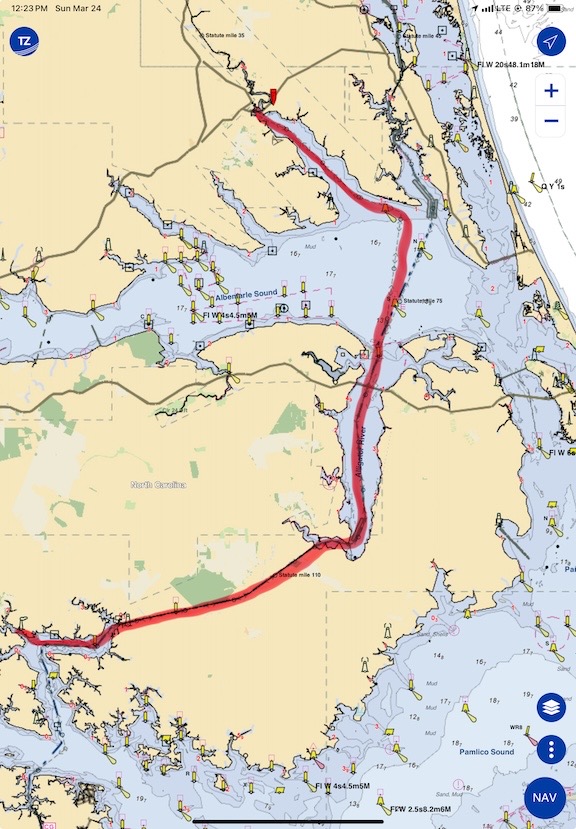
I covered more than 70 nautical miles on Thursday to get across Albemarle Sound before weather moved in on Friday.
This was perfect — or so I thought at the time. The weather for the next five days would get progressively worse with peak winds at gale force speeds on Sunday on Albemarle Sound. One of the weather models was predicting 10 foot waves. If I hadn’t crossed the sound when I did, I’d be stuck at Alligator River Marina for five days. And trust me: that’s one place you don’t want to get stuck at. But I was sitting pretty at Elizabeth City with the nice calm waters of the swamp ahead of me and an easy path to Norfolk. I even made reservations at the Hampton Town Docks for two nights starting Monday.
The locks on the Great Dismal Swamp Canal only open four times a day on a specific schedule. I was in no hurry, so I decided to shoot for the 11 AM opening. It would be a 2 to 3 hour cruise, depending on my speed. I wound up getting off a little later than I planned — almost 9 AM — so I had to do the trip at about 8 knots to get there on time. I used Aqua Map for trip planning and it told me exactly what time I’d arrive every time I changed my speed.
It was a pleasant cruise on the river which eventually shut down to a straight canal called Turners Cut. There were a lot of downed trees, but none of them blocked my path. I slowed down for the few houses along the narrowest part of the canal.
I called the lock 3 miles out. No response. Too far. I called again a mile later. This time there was some static as someone tried to respond. I kept going. When I called again about a half mile out, the voice came through clearly: “The lock is closed until April 1.”
What?
I looked at Aqua Map, which always shows Waterway Guide navigation alerts. The woman at the lock — or at least listening to the lock frequency — said there was a Notice to Mariners about it back in December. Maintenance. But I could not find any notice about it on Aqua Map or Waterway Guide.
At least not at first. As I instructed my boat’s autopilot to follow our track in back out, i combed through the Waterway Guide website. Sure enough, if I set the Explorer feature to display alerts (not locks or bridges or marinas), it was there. Literally, the last place I looked — and not a place I’d normally look. After all, navigation alerts normally appear right in Aqua Map. This one did not.
It was March 22. I was not going to wait 8 days for the lock to open. I couldn’t wait. I had a deadline. I had to get to Colton Point by April 4. I needed extra time in case weather on Chesapeake Bay delayed me. I couldn’t use up all my spare time waiting to get through the swamp.
Dealing with the unexpected.
It looked like I’d have to go back down to Albemarle Sound and take the Virginia Cut. But I couldn’t do it that day. And I couldn’t do it until the weather cleared out. In the meantime, I had to find someplace to wait out the weather, starting with the big rainstorm expected overnight and into Saturday.
I worked Aqua Map and found Lamb’s Marina. I remember someone telling me about staying there and how it was pretty good. (I later discovered that it had been Kim on Pony last year.) I called. Did they have room for me for at least 5 days? Larry, who I suspect is the owner, said to come on in.
And that’s how I found myself staying at a combination marina/trailer park in Camden, NC, waiting out the weather, enjoying amazing hot showers, and hopefully getting stuff done. Like this blog post.
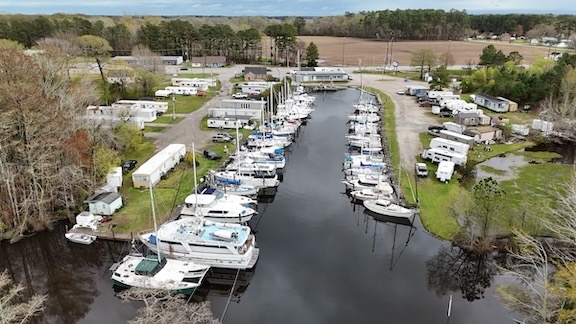
I sent my drone up after the rain stopped on Saturday. My boat is on the left side about 1/3 to the end of the fairway.
On Adventure Travel
Well, this story went on a little bit longer than I expected and I’ll probably plagiarize it for My Great Loop Adventure blog. I wanted to use it as an example of how unexpected and unplanned problems can make a trip more of an adventure and challenge.
I love challenges — I think part of me lives for them. But I won’t say I’m glad this happened. I really did want to go through the Swamp and visit the museum in there again. And maybe do a dinghy trip up one of the intersecting canals.
But this snafu reminded me that things don’t always go as planned and I need to be flexible to move on from setbacks. Although there’s a slight chance I can get back on the river and maybe into the Sound tomorrow, Wednesday looks a lot more likely. There are definitely worse places to be stuck — ask me one day about the Alligator River Marina or Rosamond, CA.
These unexpected challenges is what reminds me that I really am on an adventure. Maybe next time someone tells me that they admire me for what I’m doing, I’ll remember the real challenges, take the compliment, and thank them.




